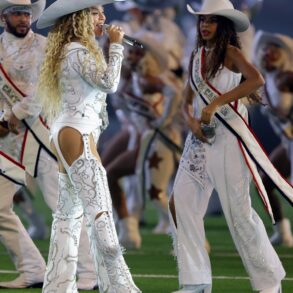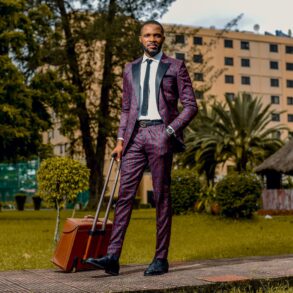Art
Maxwell Rabb
Dec 5, 2023 2:17PM
Lee Miller, Self portrait with headband, Lee Miller Studios Inc., New York, USA, c. 1932, c. 1932. © Lee Miller Archives. Courtesy of Lee Miller Archives, England and Gagosian
It’s impossible to fit Lee Miller into a single mold—the artist was a Vogue photographer, a World War II correspondent, a gourmet chef, and a member of the Surrealist movement in 1930s Paris. Despite this range, her legacy is often reduced to a limiting role: the muse. Discussions about Miller tend to circle back to her relationship with Man Ray or her friendships with male contemporaries like Pablo Picasso or Max Ernst, as epitomized in Man Ray’s The Lovers (1933), featuring only Lee’s lips hovering in the sky.
However, Miller is finally coming into focus in the public eye, primarily driven by her son and the founder of Lee Miller Archives, Antony Penrose. The forthcoming biopic entitled Lee, starring Kate Winslet and adapted from Penrose’s book The Lives of Lee Miller (1985), along with two noteworthy exhibitions—“Seeing Is Believing: Lee Miller and Friends” at Gagosian in New York City (through December 22nd) and “You Will Not Lunch In Charlotte Street Today” at TJ Boulting in London (through January 20th)—are reshaping perceptions of Miller. These exhibitions, curated in collaboration with Lee Miller Archives, highlight Miller’s deep-rooted talents, underscoring her active engagement with her contemporaries—as an artist and collaborator.
“[My goal] was not to present ‘Lee Miller the muse,’ but Lee Miller as this person that had so many lives,” said Jason Ysenburg, co-curator of “Seeing Is Believing,” in an interview with Artsy. “I wanted to show how she was involved and a participant in this whole period.…I wanted to talk about her involvement with artists.”
Advertisement
Haunted by the horrors she experienced as a combat photographer, Miller concealed her photographs in the attic of Farley Farm, where she lived with her husband, Surrealist artist Roland Penrose. She stashed away her photos and instead channeled her creative energy into cooking—concocting the infamous “Green Chicken” dish, the recipe for which she published in Vogue. By shelving the camera, she inadvertently helped others minimize her legacy, as even her son remained largely unaware of her prolific photography career until her death in 1977. Then, Antony found approximately 60,000 negatives, photos, and other documents spanning her entire life.
Unlike prior group exhibitions covering the era, “Seeing Is Believing: Lee Miller and Friends” positions Miller not as a peripheral figure but as a central, influential artist. The exhibition, co-curated by Ysenburg and Richard Calvocoressi, places Miller’s photography in dialogue with her contemporaries, including Picasso, Man Ray, Ernst, Dora Maar, Joseph Cornell, Henry Moore, and Valentine Penrose. The exhibition is framed by her long, dynamic marriage with Penrose—telling the story of the artist community they cultivated, as depicted in her photo Picnic, Île Saint-Marguerite, Cannes, France 1937 (1937).
Installation view of “You Will Not Lunch In Charlotte Street Today” at TJ Boulting, 2023. Courtesy of TJ Boulting.
“When I say Lee Miller, people usually say, ‘Didn’t she pose for Man Ray’ or ‘Is she the war correspondent?’” said Ami Bouhassane, Miller’s granddaughter and co-director at Lee Miller Archives. “She’s portrayed as [her male contemporaries’] muse, their inspiration. It’s always them doing stuff to her and not really presenting her on equal par or recognizing her input and connection and the depth of the connection that she had with them as people and as artists.”
Still, “Seeing Is Believing” features several portraits of Miller as a muse, including Picasso’s A L’Arlesienne – Portrait of Lee Miller (1937) and Maar’s Portrait of Lee Miller 1937 (1937). However, the exhibition embeds these portraits within a renewed narrative—a story where Lee Miller is an active member of the conversation and a visionary in her own right. Her cunning Surrealist eye never faltered, even in war, capturing photos in bomb shelters like Henry Moore taken during the filming of “Out of Chaos”, Holborn Underground, London, England 1943 (1943) or the oddities of wartime London in Women with Fire Masks, London, England 1941 (1941).
Installation view of “Seeing Is Believing” at Gagosian. Photo by Rob McKeever. Courtesy Gagosian
Meanwhile, “You Will Not Lunch In Charlotte Street Today” takes another innovative approach to showcasing Lee Miller’s work. In a refreshing departure from the norm, TJ Boulting director Hannah Watson chose not to include Miller’s name or title in the exhibition’s name. Instead, Watson selected a title drawn from one of Miller’s photographs, inspired by its irreverence. It’s a sign of the show’s intentions: to present Miller’s work in a new light, upheld by its merit rather than the artist’s renown.
“I’ve just found it liberating to use this title, which is Lee’s own words, and it really lets her do the talking,” said Watson. “[We feature] her Self-portrait (c. 1932), which also happens to be the earliest work, where she’s come back from Paris, she’s in New York, and she’s left Man Ray. She’s set up her studio in New York, Lee Miller Studios, Inc., and she’s the most in-demand photographer in New York, and everyone wants to have their portrait taken by her.”
Lee Miller, Women with Fire Masks, London, England 1941, 1941. © Lee Miller Archives. Courtesy of Lee Miller Archives and Gagosian.
Also noteworthy in the TJ Boulting show are Miller’s portraits of women, which mirror Miller’s own resilience and depth. These photos often nod to Miller’s desire to document her subjects without objectifying them. For example, Leonora Carrington, St.Martin d’Ardeche, France (1939) depicts Surrealist painter Leonora Carrington in an everyday light—washing her hands with a startled expression.
Elsewhere, Exploding Hand (ca. 1930–31), which pictures a hand blurred by scratched glass, marks her early foray into Surrealism. Along with Man Ray, Miller made use of solarization, a process that produces a dark halo around the edge of figures in photographs—as seen in her 1942 photograph Corsetry, Solarised Photographs, Vogue Studio, London, England, 1942.
Throughout the many chapters of her life, her early foundation in Surrealism influenced her work, where surprising and dissonant contrasts are everywhere. As a Vogue fashion photographer, she placed her models among the rubble in London, as in Model wearing Digby Morton Suit, London, England (1941). In wartime, her curiosity as an artist produced some of the most unconventional images from the era—most famously, a self-portrait taken in Adolf Hitler’s bathtub as the Allies liberated Europe. Above all, Miller found and documented contradictions through her photography, probing at subconscious tensions.
This exhibition, in concert with “Seeing Is Believing,” paints a fuller picture of Miller, not just as a figure in front of the lens or a fixture in male artists’ lives but as a groundbreaking artist and an impactful chronicler of her times. They place Miller in the pantheon of influential 20th-century artists, where she rightfully belongs.
Maxwell Rabb
Maxwell Rabb is Artsy’s Staff Writer.
This post was originally published on this site be sure to check out more of their content.





